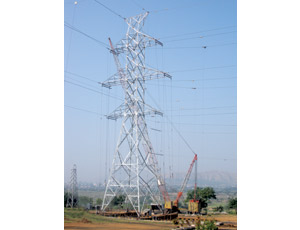The Bonneville Power Administration, a federal agency that markets electric power from the Columbia River’s Bonneville Dam in the Pacific Northwest, is saving millions of dollars on construction of its latest transmission line and expects to save more in the future, thanks to new tower design and analysis software developed by one of its own engineers.

Portland, Ore.-based BPA says the Advanced Tower Analysis and Design software makes new towers easier to assemble and better able to withstand extreme weather and loading.
The program, designed by BPA structural engineer and self-taught software designer David Hesse, can analyze dozens of scenarios and structural options for transmission towers to develop the least costly, most efficient structure for a transmission tower in a single day. Previously, BPA’s exploration of such variations would be done by hand and take months, Hesse says.
According to BPA, the program is expected to save the agency $11 million on the $250-million McNary-John Day line, currently under construction in Washington and Oregon, and $7 million or more on the $99-million Central Ferry-Lower Monumental line, which is scheduled to start construction this summer.
The cost savings come from the ability to design towers with less steel. Less steel means the towers are lighter, easier to transport and easier to erect. “If we can save 10% on weight, we can save 10% on costs,” Heese says. Savings per tower range from 20% to 35%—or $18,000 to $270,000—or more. The more precise engineering reduces the number of towers required. A redesign of the Central Ferry Line in Washington state resulted in 159 towers—22 fewer than first planned.
BPA expects to need about 10 new high-voltage transmission lines as it integrates more than 6,000 MW of wind power on the grid. The money it expects to save will allow more lines to be built.
Hesse says the software lets engineers vary the load requirements for a tower to see if a particular design can meet them. Then, the engineer can try lighter variations of the configuration, and the program will evaluate whether the revised design will meet the loading requirements, too.
“The most challenging part in tower design is the infinite number of configurations,” says David O’Claire, structural design manager for BPA. “You can move a piece of steel in one place and end up with problems in another. It’s trial and error.”
In designing the largest towers of the McNary-John Day line, engineers using the program were able to replace four large legs—each made of two thick plates welded together—with four smaller legs that could be manufactured at a steel mill and bolted together at right angles. That design change saved $300,000 per tower, each of which costs more than $1 million.

HESSE
Previously, Hesse says, structural engineers would have designed each tower with one set of variables and then built and field-tested it before proceeding.
John Chan, a transmission program manager for the Electric Power Research Institute, Palo Alto, Calif., says if the program can mimic a field test, it is an important development.
Hesse says improvements in transmission-tower design have stagnated because, prior to a recent pickup in construction, there were few new transmission lines being built for several years.
BPA operates three-fourths of the high-voltage transmission lines in the Pacific Northwest. It has been using tower design software since the 1960s, and Chan says it has been a leader in using software for that purpose. Hesse started working on improving the software in 1991.
Hesse says he isn’t aware of any plans to license the software, although BPA has been allowing other utilities to use it.
Lynette Berriochoa, a spokeswoman for Idaho Power, says that utility is reviewing BPA’s new towers but notes that requirements vary by state and utility.
div id="articleExtras"
Post a comment to this article
Report Abusive Comment